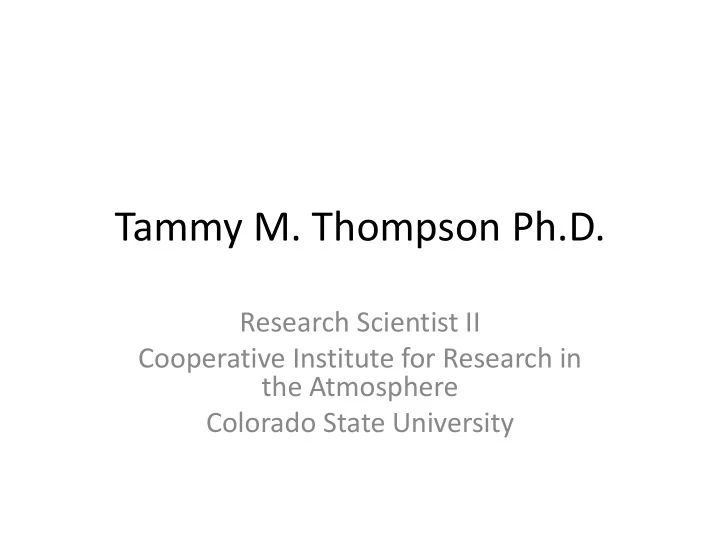

Tammy M. Thompson Ph.D. Research Scientist II Cooperative Institute for Research in the Atmosphere Colorado State University
What is Known about Ozone • Ozone is formed through complex, non-linear reactions between Nitrogen Oxides (NOx) and Volatile Organic Compounds (VOCs) in the presence of sunlight • Ozone precursors can react and form ozone locally, and they can also travel and react far from where they were emitted making ozone a local, regional and increasingly a global issue • VOCs emitted from Oil and Gas (O&G) Operations can lead to the formation of ozone
NOAA’s HYSPLIT Model creates “Back - Trajectories” showing the path and speed of air flow Source: Air Pollution Control Division, State of Colorado.
Use HYSPLIT wind speed and direction data to show likelihood that air traveled through a certain point before reaching Rocky Mountain National Park in 2009 Source: Gebhart et al., 2014. Submitted.
Spring 2006 Residence Time Map Source: NPS 2009 Report: Rocky Mountain Atmospheric Nitrogen and Sulfur Study, Volume 2.
Summer 2006 Residence Time Map Source: NPS 2009 Report: Rocky Mountain Atmospheric Nitrogen and Sulfur Study, Volume 2.
Current Colorado O&G Well Locations (Red dots) and Shale Basins (Green Areas) Source: COGCC GIS O&G Well Locations Updated Daily. Available at: http://cogcc.state.co.us/Home/gismain.cfm Basin Boundaries from EIA: http://www.eia.gov/pub/oil_gas/natural_gas/analysis_publications/maps/maps.htm#shaleplay
Summer 2006 Residence Time Map Source: NPS 2009 Report: Rocky Mountain Atmospheric Nitrogen and Sulfur Study, Volume 2.
Two Examples of Ozone (> 75 ppb) in Rural areas occurring as a direct result of O&G activity • Uinta Basin, Utah • Upper Green River Basin, Wyoming – Declared non-attainment in 2012. • What Scientists know: – Requires Snow Cover – Very Stagnant Air and Shallow Boundary Layer – Emissions of ozone precursors from O&G activities – These are NOT unique characteristics! • Scientists suggest that winter-time ozone could be occurring in other non-monitored regions of the US as a result of O&G activities 1 . 1. Schnell, R.C. et al., 2009. Rapid photochemical production of ozone at high concentrations in a rural site during winter. Nature Geoscience 2, 120 – 122.
Colorado O&G Well Map with AQ Monitor Locations (Yellow Boxes)
Modeled Impacts of O&G VOC emissions in the Non-Attainment Area • Results include thirteen days in a June/July 2006 modeling episode with modeled ozone concentration greater than 70 ppb at Greeley monitor (Weld Tower) • Greeley monitor model result statistics: – Average ozone concentration 72 ppb (of 13 “high” days) – Average contribution from in-state sources 17 ppb – Average contribution from O&G VOC emissions 1 ppb (5% of controllable emissions on average) – Contribution from O&G VOC emissions > 2 ppb on four days – On three days, ozone would be below 70 ppb if O&G VOC emissions were eliminated Source: Modelling conducted by ENVIRON on behalf of the DGS group and submitted as Exhibit RR in the DGS Prehearing Statements.
2008 Modeling results show widespread ozone decreases (right column) as a result of a 20% reduction in VOC emissions from O&G in the Denver/Julesburg Basin
Two Methods To Estimate Emissions: “ Bottom Up ” and “ Top Down ” Ambient Measurements Equipment Count + Meteorological Data x Production Factor + Inverse Modeling x Emissions Factor + Unique Tracers or Ratios Emissions Estimate Emissions Estimate • In Colorado, these two sources of emissions estimates do not match and scientists are working hard to understand why. • Top down estimates suggest that bottom up inventories under-estimate VOC emissions from O&G by 50 – 200% 1,2 . 1. Gilman, J.B. et al., 2013. Source Signature of Volatile Organic Compounds from Oil and Natural Gas Operations in Northeastern Colorado. Environ. Sci. Technol. 47, 1297 – 1305. 2. Swarthout, R.F. et al., 2013. Volatile organic compound distributions during the NACHTT campaign at the Boulder Atmospheric Observatory: Influence of urban and natural gas sources. Journal of Geophysical Research: Atmospheres 118, 10,614 – 10,637.
Recommend
More recommend